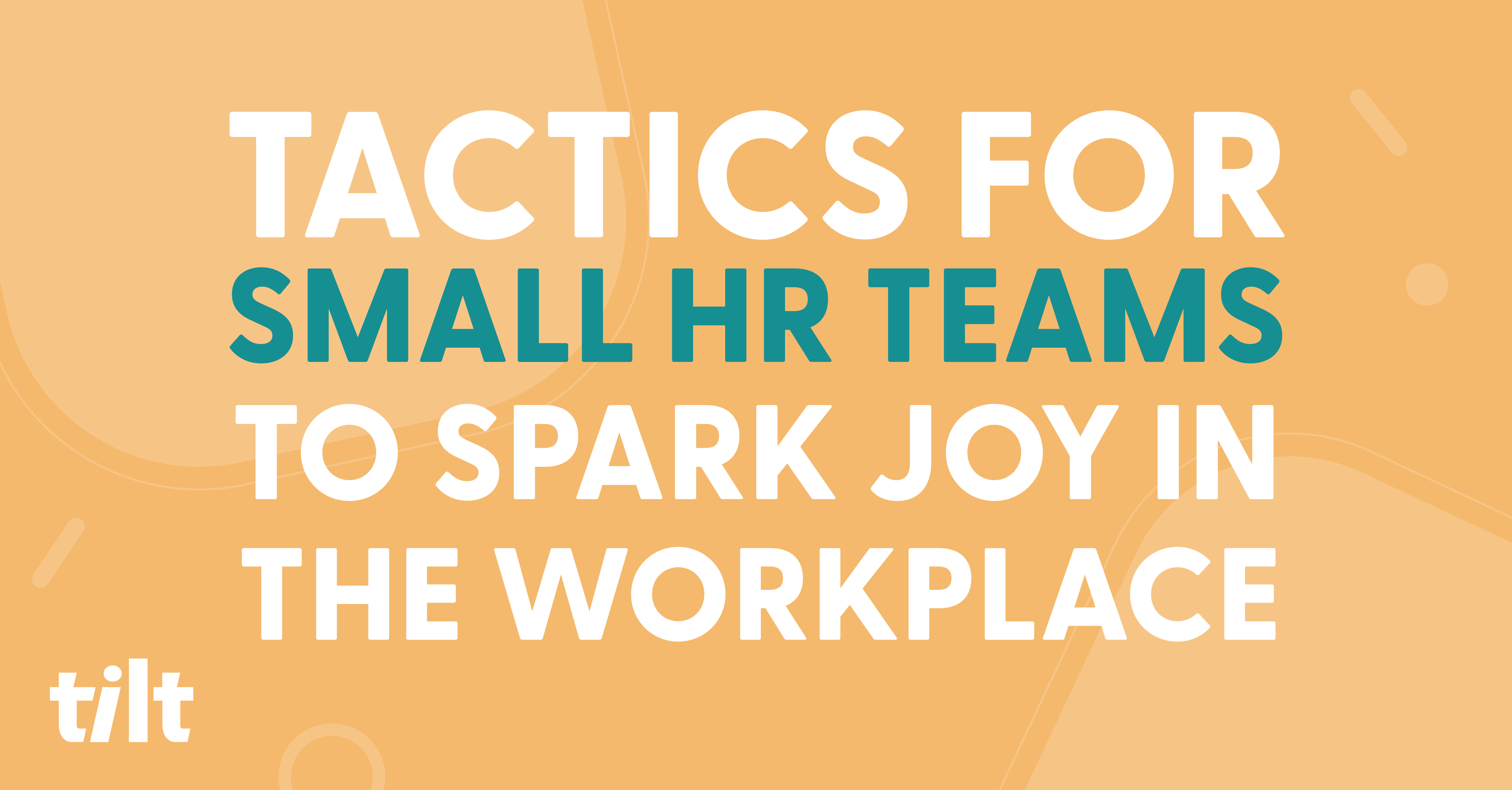Nimble. Agile. Small but mighty. Flexible. Efficient. Punching above their weight. Dynamic.
These words and phrases are often used to describe small teams within an organization that are asked to do a lot with a little, or in some cases nothing at all. And while hearing descriptors like this ad nauseam might diminish their meaning over time, it doesn’t take away from the fact that if you’re a small HR Team or a team of one (we see you, fam), you’ve got a tremendous amount of responsibility and minimal bandwidth, so embodying those buzzwords will likely suit you well.
Among the many day-to-day tasks you’re charged with is maximizing overall happiness in the workplace. It’s an undertaking as critical to business success as it is ambiguous to tackle. In fact, organizations with high job satisfaction rates witness 31% more productivity and 37% higher sales.
Satisfied employees are more productive employees, So how can “small but mighty” HR teams spark joy in the workplace effectively, efficiently, and in ways that matter most to your people? Let’s dive in.
How Small HR Teams Can Drive Joy and Boost Workplace Productivity
Nurture workplace recognition: Workplace recognition can take a variety of forms, to the extent that some employees may be happier and more productive not being recognized at all and are just allowed to do what they do and not be bothered.
However, numbers don’t lie, and all signs indicate that workplace recognition has a strong correlation to employee productivity. Recent findings show that 78% of employees would be more productive if they were recognized more frequently.
There’s a strong business case for it too. Developing a recognition program does more than just give your employees all the feels, it can help your organization better identify rising stars within your organization and help develop their careers accordingly. Similarly, it has the power to strengthen relationships across the organization, as well as up and down it.
Since you can’t be everywhere at once, tap team leaders within your organization and have them regularly think about the following questions:
- Were there any highlights or major accomplishments this week?
- Did I learn something new from my team?
- Did my team do something that went above and beyond?
- What conversation or experience stuck with me this week?
- How did the projects we are working on progress this week?
This approach allows you to leverage individuals within your organization who are in the know about to whom recognition should be bestowed on a frequent basis. Be thinking more weekly/monthly and less quarterly/yearly.
Enhance the leave of absence experience: Want to know what makes employees really happy? Knowing that when life’s biggest moments happen their employer makes it easy to transition from work, to real life, and back to work again.
An easy leave process signals to employees that your approach to work-life balance is more than just boilerplate lingo on a job description. Have employees return to work happier and more engaged, delivering their best work possible.
Doing this on your own might be a tall order as leaves of absence are intricate, complex, and rife with compliance risks. If you’re running a skeleton HR crew (or a solo one), seek out modern leave software solutions to ease your burdens, improve workforce planning, reduce burnout, and cultivate a happy, supported, and productive employee population.
Be visible: We aren’t recommending you buy a bunch of reflective clothing (though you do you if that’s your vibe), but there’s no denying that HR visibility plays a pivotal role in fostering this happiness within your organization.
When HR professionals are accessible and visible to employees, it enhances communication, trust, and transparency within your organization. As an HR and People Ops leader, you’re the embodiment of your company culture, so your visibility allows employees to feel seen and connected, which strengthens their sense of belonging. When employees feel like they belong, you guess it, they’re happier and more productive!
Another aspect of being visible that brings joy to your employees is that your visibility helps facilitate the resolution of issues promptly. Employees expect responsiveness from their employer when an issue is raised, so proactively addressing concerns as they arise contributes greatly to a positive and supportive company culture.
Hire happy people: We all have that one friend who continues to make the same mistakes over and over and wonders why the results don’t change (if you don’t think you have a friend like that…have a seat…). Well, the same can be said for hiring patterns. While it’s not an exact science, it’s certainly not rocket science to see it takes less effort for a small HR team to keep people happy who are naturally happy than it takes to extract happiness out of curmudgeons (what a word, right?) who happen to be highly skilled in their role.
Another thing that brings employees joy is being around colleagues who are joyous. Just like we learned in high school chemistry class, “like dissolves like.” Meaning, two objects that are similar to one another are more likely to bond.
The importance of hiring happy people can’t be overstated when it comes to cultivating joy in the workplace. Day after day, year after year, work can wear down even the most dedicated of professionals. This is why it’s vital to have a workplace filled with as many happy employees as possible because when the inevitable down days arrive, it’s the joy that you’ve been cultivating within the walls that will lift your employees up when they need it most.
Why Are Happy Employees More Productive?
You know that old saying, “The beatings will continue until morale improves?” Well as fun as it is to laugh at such a paradoxical concept, a surprising number of organizations still approach workplace productivity with this mindset, albeit a much more watered-down and legal version of it.z
Employers of choice know that productivity in the modern workplace is established on a cultural foundation of joy and happiness among its employees. Here’s why:
Happy Employees Are More Motivated: Happy employees are more likely to feel a sense of purpose and satisfaction in their jobs. Having a sense of purpose is a significant driving force behind motivating employees to perform at a high level, whereas Job satisfaction leads to increased productivity as employees feel engaged and committed to their roles, driving them to excel in their objectives.
Purpose + Satisfaction = Happy & Motivated Employees
If you ever forget that, just remember P+S=H&ME. Actually, feel free to forget that…let’s move on.
Happy Employees Contribute to a Positive Work Environment: It’s a bit reductive to say that a positive work environment contributes to employee happiness because it’s a bit of “which came first, the chicken or the egg?” Taoist philosophy would say that employee happiness and a positive work environment arise mutually.
Wherever you see a positive work environment, you see happy employees. Wherever you see happy employees, you see a positive work environment. The two are interdependent, which is why a workplace that fosters collaboration, communication, and a supportive culture tends to grow happier employees with lower stress, high morale, and increased productivity.
Happy Employees are More Creative and Innovative: According to a recent study that links creativity to joy, more than half of adults who do creative activities describe themselves as optimistic (55 percent) and happy (53 percent). The correlation between joy and creativity in the workplace can’t be denied either, as creative employees tend to be open to new ideas, take risks, and contribute positively to problem-solving and innovating.
Happy Employees Are Committed: If you’ve been around long enough, you know how rare it is an employee to be happy in your work environment, which is why establishing a culture of joy is so critical. Happy employees are more likely to stay committed to their jobs and the organization, partially because of all the reasons listed above, but also due to the fact that they know the grass is yellower and more itchy elsewhere.
This reduces turnover, keeps institutional knowledge in-house, and develops employees long-term who tend to be more familiar with their roles, leading to increased efficiency and productivity.
When you foster employee happiness in your organization you’re doing more than just bringing joy to the people you support. You’re cultivating a motivated, satisfied, and engaged workforce who are more likely to excel in whatever it is they’re doing on a daily basis.
This positive environment reduces their stress, encourages creativity, and promotes effective collaboration. The resulting boost in productivity is accompanied by lower turnover rates, as happy employees are committed to their jobs and the organization. Prioritizing employee happiness not only enhances individual well-being but also contributes to a thriving workplace where innovation, teamwork, and job satisfaction collectively drive a more productive and successful workforce.
Create Joy in The Workplace and Watch Your Organization Thrive
As a People Ops pro on a small team, you’re expected to be nimble, agile, flexible, efficient, and dynamic. While that seems like an awful lot of adjectives for one human to embody, small but mighty teams can easily punch above their weight if focused on the right things and find the right solutions to make their job easier.
Sparking joy through recognition, better leave of absence experiences, being visible, and hiring happy people can have a tremendous impact on employee joy, motivation, job satisfaction, retention, production, and overall business success.
About Tilt
Tilt is leading the charge in all things leave of absence management through easy-to-use tech and human touch. Since 2017, our proprietary platform and Empathy Warriors have been helping customers make leave not suck by eliminating administrative burdens, keeping companies compliant, and providing a truly positive and supportive leave of absence experience for their people.







